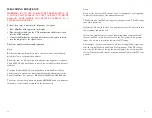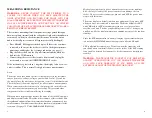
12
MEASURING FREQUENCY
WARNING:
IF YOU TRY TO MEASURE THE FREQUENCY OF
A SIGNAL THAT EXCEEDS 750 VOLTS AC RMS, YOU MIGHT
DAMAGE, YOUR METER AND EXPOSE YOURSELF TO A
SEVERE SHOCK HAZARD.
Follow these steps to measure the frequency of a signal.
• Press dBm/Hz. kHz appears in the display.
• Plug the red test lead into the V Hz terminal and the black test lead
into the COM terminal.
• Connect the black probe a ground reference for the signal, and con-
nect the red probe to the signal source.
The meter displays the measured frequency.
Notes:
Because measuring frequencies takes several seconds, the keyboard
might be slow to respond to key presses.
The meter uses a 1 Hz gate signal to measure the frequency of signals
below 4000 Hz. You might have to wait a few seconds for the display to
stabilize.
For signals above 4000 Hz, you might have to manually set the fre-
quency range to prevent the meter from displaying a harmonic of the
actual frequency. (See page 13,
M
ANUALLY
S
ELECTING
THE
R
ANGE
.)
The meter does not beep when it updates MIN/MAX when you measure
frequency, even if you have turned on the beep option.
5
Notes:
If you set the meter for DC current, the (–) sign appears or disappears
to indicate the polarity of the measured current.
The 400 mA and the 4000 A ranges are fuse-protected. The 10A range
is not fuse-protected.
If the meter blows a fuse while you measure current, the meter displays
the overrange indication or 0.
If the meter displays the overrange indication when you measure AC
current, and the circuit does not exceed the AC current in the present
range, the circuit is exceeding the meter's DC rating.
For example, if you try to measure a DC power supply's AC ripple cur-
rent, the signal has both an AC and DC component. If the DC compo-
nent exceeds the meter's rating, the meter displays the overrange indi-
cation. To measure this current, you must externally block the DC com-
ponent.








